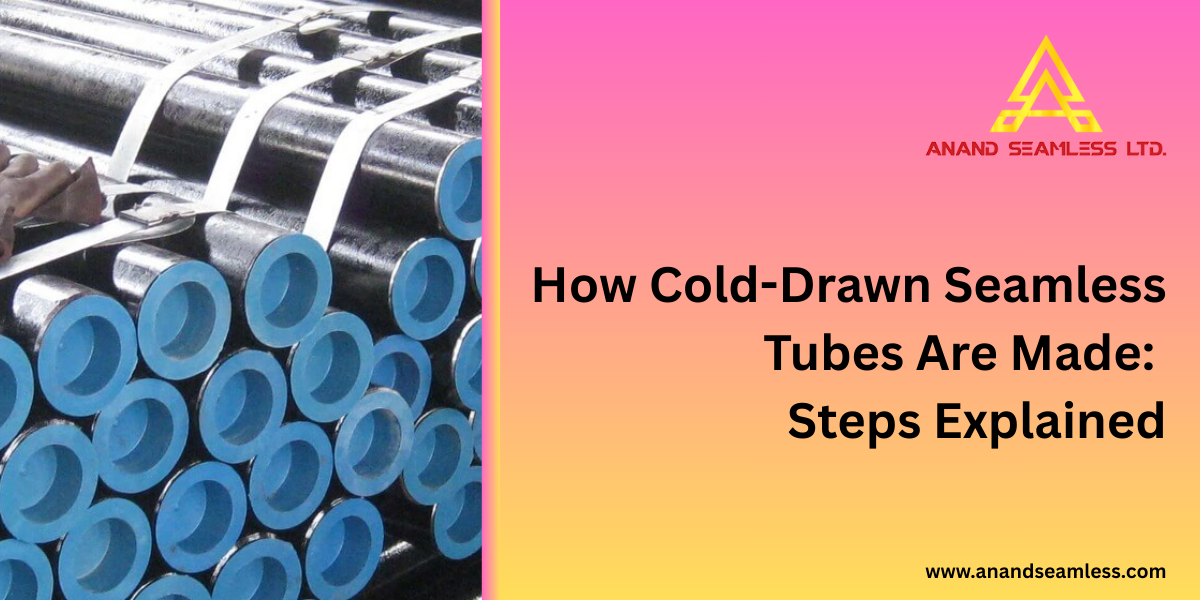Quick Inquiry
Seamless tubes are critical components in industries like automotive, aerospace, construction, and energy. Their strength, durability, and high-pressure resistance make them essential for various applications. Among the various types of tubes, cold-drawn seamless tubes stand out due to their enhanced mechanical properties, tight tolerances, and superior surface finish.
This article explains the manufacturing process of cold-drawn tubes, providing businesses with a comprehensive understanding of how these tubes are produced.

What Are Cold-Drawn Seamless Tubes?
Cold-drawn seamless tubes are made from a solid billet of steel that undergoes multiple stages of processing. Unlike welded tubes, these tubes do not have any seams or welds, making them ideal for applications that demand high strength and resistance to corrosion. The “cold drawing” process refers to the method of reducing the diameter and increasing the length of the tube by pulling the heated billet through a die at room temperature.
The resulting tubes have precise dimensions, smooth surfaces, and superior mechanical properties. This makes them ideal for applications that require excellent structural integrity, such as in heat exchangers, boilers, and pressure vessels.
The Cold-Drawn Seamless Tube Manufacturing Process
Step 1: Billet Selection and Heating
The manufacturing process of cold-drawn seamless tubes starts with selecting a high-quality billet, which is a solid cylindrical piece of steel. These billets can be made from various materials, including carbon steel, alloy steel, and stainless steel, depending on the intended use of the tube.
Once the billet is selected, it is heated in a furnace to a temperature that makes the steel more malleable and suitable for the drawing process. The heating process ensures that the steel is at the optimal temperature for shaping without compromising its mechanical properties.
Step 2: Piercing
The heated billet is then transferred to a piercing mill, where it is pierced to create a hole in the centre. This step is crucial as it transforms the solid billet into a hollow tube. The piercing process is typically carried out using a rotary piercer, which creates a uniform hole in the centre of the billet.
After the hole is formed, the billet is now referred to as a hollow shell, and it is ready to undergo the next stage of the manufacturing process.
Step 3: Elongation and Stretching
After the piercing process, the hollow shell is subjected to elongation or stretching. This is done by pushing the shell through a set of rollers or dies that gradually reduce its diameter and increase its length. This process is commonly known as extrusion, where the hollow shell is stretched into a rough tube.
At this stage, the tube is not yet the final product but has already undergone significant changes in shape. It is important to note that the elongation process must be done carefully to maintain the integrity of the tube and avoid defects.
Step 4: Cold Drawing
Once the tube has been elongated, it undergoes the cold drawing process. Cold drawing involves pulling the rough tube through a series of dies that reduce its diameter while simultaneously increasing its length. The drawing process is conducted at room temperature, which helps in improving the mechanical properties of the tube, such as its yield strength and surface finish.
The cold-drawing process is carried out multiple times to achieve the desired diameter, wall thickness, and surface finish. This process also helps to achieve the tight tolerances that cold-drawn seamless tubes are known for. Depending on the specifications, the tube may be drawn several times through different dies until the final dimensions are reached.
Step 5: Heat Treatment
After cold drawing, the tube undergoes a heat treatment process. Heat treatment is crucial as it helps relieve internal stresses and improves the tube’s mechanical properties. The tube is heated to a specific temperature and then cooled, either in air or through water quenching, depending on the material and desired properties.
Heat treatment also helps to enhance the hardness and ductility of the tube, making it suitable for high-pressure applications. This process can include normalising, annealing, or stress relieving, depending on the material used and the final application.
Step 6: Surface Finishing
The surface of the cold-drawn seamless tube is critical in ensuring that the tube performs well in its intended application. After heat treatment, the tube may undergo various surface finishing processes such as polishing, pickling, or coating to improve its surface quality. Polishing helps remove any rough spots or scale from the surface, while pickling removes any oxidation that may have occurred during the heating process.
Surface finishing is essential for ensuring that the tube meets the required specifications and is free from any defects that could affect its performance.
Step 7: Testing and Inspection
Before the cold-drawn seamless tubes are sent to customers, they undergo rigorous testing and inspection to ensure they meet the required standards. These tests include:
- Dimensional Inspection: To ensure that the tube meets the required specifications for diameter, wall thickness, and length
- Mechanical Testing: To test the tensile strength, yield strength, hardness, and ductility of the tube
- Non-Destructive Testing (NDT): Such as ultrasonic testing and eddy current testing to detect any internal or surface defects
- Hydrostatic Testing: To check the tube’s ability to withstand high-pressure conditions without bursting
Only tubes that pass all these tests are approved for shipment, ensuring that they meet the highest standards of quality and performance.
Talk to a Tube Specialist!
Applications of Cold-Drawn Seamless Tubes
Cold-drawn tubes are used in a wide range of industries due to their excellent mechanical properties and durability. Some of the common applications include:
- Heat Exchangers: Cold-drawn seamless tubes are ideal for heat exchangers due to their excellent heat transfer properties and resistance to thermal stress.
- Automotive Industry: Used in the manufacturing of hydraulic cylinders, power steering systems, and other components that require high strength and precision.
- Oil and Gas Industry: They are used in drill pipes, casing pipes, and other components that need to withstand extreme pressure and harsh environments.
- Aerospace Industry: These tubes are used in the manufacture of aircraft components that require lightweight yet strong materials.
- Construction Industry: They are used in structural applications where high strength and reliability are required.
Why Choose Anand Seamless Limited for Cold-Drawn Seamless Tubes?
At Anand Seamless Limited, we pride ourselves on delivering high-quality cold-drawn seamless tubes that meet the specific needs of various industries. With state-of-the-art manufacturing processes, stringent quality control measures, and a commitment to customer satisfaction, we are a trusted seamless tube manufacturer in India.
Whether you are looking for carbon steel, alloy steel, or stainless steel seamless tubes, our cold-drawn tubes offer unmatched strength, durability, and precision. Reach out to us at +91-9099996853 (International) and +91-9909968550 (Domestic) to book a free consultation or to get a detailed quote for a specific application. We will be happy to provide you with an ideal solution.
lATEST BLOG |
|
Finned Tube Heat Exchanger Selection Guide for Rice Mills, Dairy and Food Plants in India
A finned tube heat exchanger is one of the most im |
|
Why Cold-Drawn Tubes Are the Best Choice for Aerospace Component Manufacturing
When it comes to aerospace manufacturing, the sele |
|
How Seamless Steel Pipes Ensure Safety in High‑Pressure Boiler Systems
When it comes to ensuring the safe operation of hi |
|
Why Seamless Tubes and Pipes Are Gaining Popularity in Heavy-Duty Industries
In the world of heavy-duty industries, where high |
|
How Finned Tubes Help Combat Fouling in Heat Exchangers: Solutions for Clean Heat Transfer
Heat exchangers are the heart of many industrial s |

